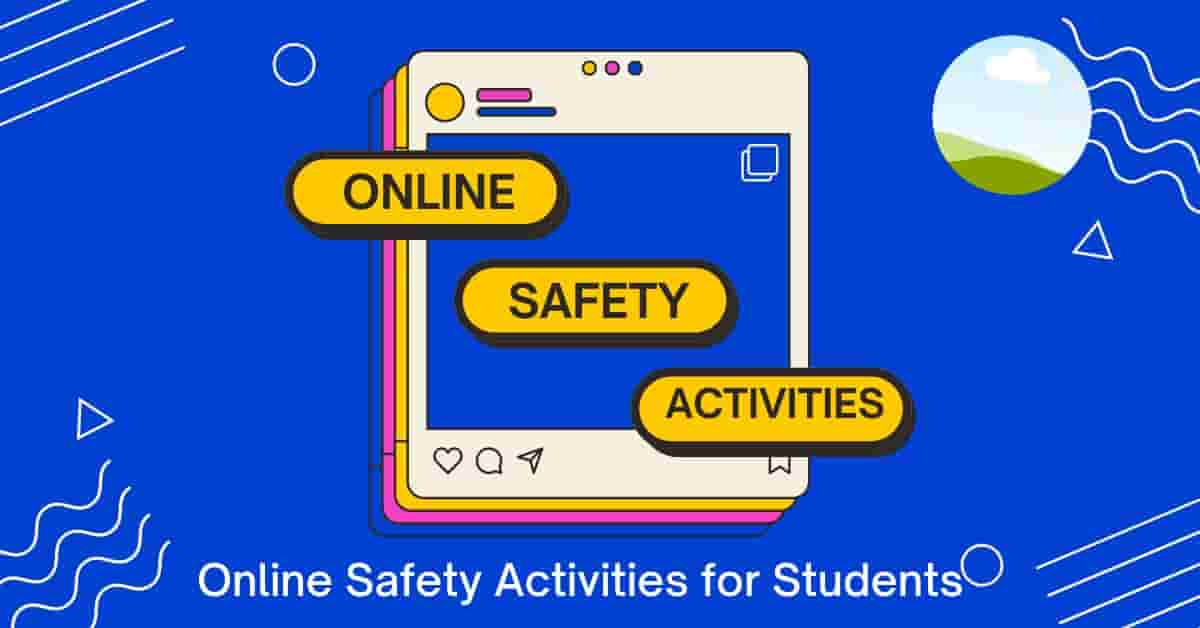Do you want to learn about online safety activities for students to prevent online dangers? Then, this article is very significant for you. In today’s fast-paced digital world, students spend greater lengths of time interacting with the internet whether it is for school homework, socializing with friends through social media, or gaming.
But it is not all sunshine and rainbows; there are darker sides to using online space; hence it needs every student online to be at least familiar with all that one needs to know about online safety activities for students.
The article will touch on some very practical and interesting online safety dramas one can take up with their students. Let’s start to learn about the online safety activities for students.
Why Online Safety Activities for Students Are Important
Online safety activities for students will teach them the dangers that the Internet may expose them to. They learn how to tactically defend their personal information, avoid scams, and communicate responsibly.
Online activities can be valuable resources but have also given exposure to students dangers such as:
- Cyberbullying
- Phishing attack
- Inappropriate content
- Identity theft
Teaching how to move in that virtual world makes a student a good digital citizen.
Recommended reading: 10 Tips on How to Promote Literacy in Early Childhood
Engaging in Online Safety Activities for Students
- Password Challenge: Teach students to create strong passwords, using a game combining uppercase letters, numbers, and special characters-they can play it by building a secure password. Use an Interactive activity where students test their passwords using an online tool for strength.
- Phishing Scavenger Hunt: Show students phishing emails and ask them to look for clues like misspellings in the emails, suspicious links, or urgent language that gives them information that the email is a phishing attempt.
- Role-Play on Safe Social Media Practices: Students can create a skit depicting different online scenarios: how to manage online bullying or fake profiles, or how to handle oversharing.
Table: Online Safety Do’s and Don’ts
| Do’s | Don’ts |
|---|---|
| Use strong passwords | Share the password with that other user |
| Enable two-factor authentication | Click unknown links |
| Think before posting | Share personal information publicly |
| Report any suspect activities. | Disregard cyber bullying |
- Cyber Safety Quiz: Conduct an online safety quiz for students about the activities done online. Questions for the quiz should cover safe browsing, malware, and responsible online behaviors.
Table: Common online threats and prevention.
| Threat | Prevention |
|---|---|
| Phishing | Don’t click on suspicious emails. |
| Cyberbullying | Report and block bullies. |
| Hacking | Use updated security software. |
| Inappropriate content | Enable parental controls. |
- Digital Footprint Activity: The students should search for their name online, after which a discussion about the effects their online existence may have on one’s reputation would follow.
Recommended reading: studies on homeschooling vs public schooling
Essential Tips For Online Safety Activities

1. Teaching Internet Etiquette
Online safety activities also concern manners. Train students on how to:
- be polite in an online chat;
- refrain from sharing personal information; and
- report inappropriate content.
Role-play scenarios could spice up such lessons.
2. Online Safety Posters
Have students create an online safety poster with such messages as:
- Do not share passwords.
- Think before you click.
- Report cyberbullying.
Hang these posters around the classroom or share them online.
3. Interactive online safety games
Many sites already have online safety games. The games can be fun and interactive ways to learn about internet safety. Students can earn points and experience while completing challenges online.
4. Parental Involvement
Online safety activities for students become more effective with the active participation of parents. Help them with:
- Monitoring their online activities as a child.
- Setting parental control.
- Talking about safe navigating habits online.
5. Safe Browsing Habits
Fun activities teach students safe browsing behavior. These can include:
- how to identify secure websites (whenever possible look for HTTPS).
- avoid clicking on any unidentified links.
- use antivirus software.
Make the teaching of these findings participatory: conduct a puzzle or team competition.
6. Real-Life Scenarios
Provide instances where online security has been breached in real-life scenarios. Explain what was done wrong and the way it could be averted. This would make the students feel the online safety activities more relevant.
7. Online Safety Contracts
Make an online safety contract. Students can sign in to make a contract for their commitment to following the safety rules of the internet. You may include:
- Do not disclose personal information.
- Always report suspicious behavior.
- Use strong passwords.
Recommended reading: special education resources
Benefits of Knowing Online Safety Activities for Students
Some activities mention:
- Higher awareness of the dangers of the internet.
- Better decisions in digital spaces.
- Increased confidence about challenges that may happen online.
- Better communication.
Internet safety activities for primary school
Internet safety activities for primary school are important in the current digital world where children learn how to navigate the internet. Fun and simple activities can explain online threats to very young children. For example, one activity is to make online safety rules posters. Kids can draw and write down suggestions such as “Don’t share personal information” or “Ask an adult before clicking a link.”
Scenario role-plays are yet another method by which students can be taught. For example, a teacher can role-play as an online stranger and have students practice saying no to sharing private information. Internet safety activities for primary school children should also involve online interactions through games. These teach children how to differentiate between safe and unsafe websites for them.
Another interactive way to learn is by having discussions on online behavior. Questions such as, “What would you do if someone asked for your password?” could get the children engaged. Primary school internet safety activities create awareness among children and keep them safe while on the internet.
Recommended reading: lack of parental involvement in education
Internet Safety Activities for High School Students
Internet safety activities for high school students are all about responsible behavior online and teach students about the risks of cyberbullying fraud, and privacy losses. Group real-life discussions such as threats tended against their being familiar with the subject. Interactive workshop training by itself can teach safe password-keeping and safe social media.
Role-play scenarios can teach handling online predators or phishing emails. Lesson plans, quizzes, or fun game-like events may also be conducted by teachers on internet safety activities for high school students. One more good method would be creating a digital contract in which students agree to abide by the rules of safety.
Students can share experiences in peer-to-peer sessions. Schools may also invite cyber security experts to hold seminars regarding safe browsing. Regular internet safety activities for high school students keep the students updated about online trends and perils. As such, continued practice by the students shall make them capable of confidently accessing the digital world without compromising personal information.
Recommended reading: how to socialize for introverts
Final Thought on Online Safety Activities for Students
Teaching online safety with fun and engaging activities will instill students with lifelong skills. The right tools and guidance equip students to explore the digital world safely. Start using these online safety activities for students now and make a safer online environment for them. Teaching skills will help ensure that the online environment is safer for students. Such activity should be undertaken today, empowering students to act safely online.
FAQs on Online safety activities for students
1. How to teach internet safety in the classroom?
Explain internet safety through the potential risks of online use. Use real-life examples. Show safe browsing habits. Teach strong passwords. Discuss cyberbullying. Encourage reporting issues. Promote respectful communication. Use interactive activities. Repeat lessons frequently.
2. What are 5 ways to stay safe on the Internet?
- Make use of secure passwords and update them often.
- Don’t share personal info through social networking websites.
- Exercise caution while clicking on links or downloading content.
- Ensure updated software and antivirus.
- Use secure websites denoted by “https” in the URL.
3. What is the best way to teach children about online safety?
Teach kids about online safety from the perspective of why sharing personal information, talking with strangers, or clicking on unknown links is dangerous. Set rules and have them talk openly about what they did online.
4. What are the four C’s of internet safety?
The four C’s in internet safety include the following:
- Content: Think before what you share online.
- Contact: Be aware who you are communicating with.
- Conduct: Show respect and be responsible when being online.
- Commerce: Secured personal data and finances.
5. What is one activity I could use in my future classroom to teach students about internet safety issues?
Create an Internet Safety Poster. The students will research topics such as passwords, privacy, and cyberbullying and create posters. Then, each student presents their poster to the class.
6. How do I teach my 10-year-old about internet safety?
Teach children how paying attention means keeping personal info private, using strong passwords and never sharing, being careful about clicking links, coming to you first before starting a conversation with a stranger online, and finally always staying respectful.
7. What is the learning objective of Internet safety?
The Internet Safety Learning Objective is to make people aware of using the Internet responsibly to help them prevent and protect their personal information from danger and educate them about the risks associated with online usage so that they can stay safe.
8. How to be safe on the internet for kids?
An internet safety rule for kids is never to share personal information, always use strong passwords, talk to a trusted grown-up, never chat with strangers, and report any suspicious behavior. Always follow safe sites.
9. How to explain internet safety to a child?
It is like that: the internet is a medium to learn and get yourself entertained, but might not necessarily have everybody else on the planet being nice. Never share private information and always consult a trusted adult if you are in doubt.
10. What can you do for internet safety?
With strong passwords, limited sharing of personal information, and mindful clicking of links or file attachments that were not sent, a person is surfing a safe internet. Update software regularly and get a two-factor authentication for more security.
Recommended reading: how to create an inclusive learning environment in the classroom

I am a content writer and English educator with over 10 years of professional experience. With a master’s degree in English Language and Literature, I specialize in creating educational content that is clear, practical, and easy to understand. As the founder of TakeEasily.com, I’m dedicated to helping students, parents, and teachers with valuable learning resources and insightful guides.

